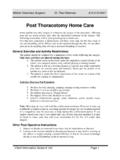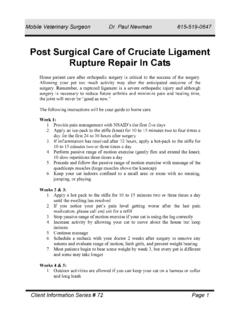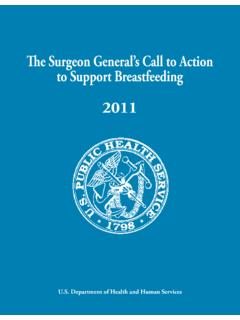Transcription of GDV Gastropexy Post Surgical Home Care - Mobile Vet …
1 Mobile Veterinary Surgeon Dr. Paul Newman 615-519-0647 Client Information Series # 92 Page 1 GDV Gastropexy post Surgical home care home patient care after surgery is critical to the success of the procedure. Allowing your pet too much activity may alter the anticipated outcome of the surgery. The following instructions will be your general guide to home care . Your surgeon may have more detailed instructions for you regarding a rehabilitation program for your pet s specific surgery. General Exercise and Activity Restrictions: The patient should be confined for a minimum of two weeks following the surgery to allow the abdominal incision to heal.
2 Only three activities are allowed during this time: 1. The patient can be in the house under the immediate control (leash) of the owner, on a carpeted surface only, without playing or fooling around. 2. The patient is left in a traveling kennel or exercise pen while unattended (see notes on exercise pens and kennels). Never put the patient in an outside run, patio or free in backyard. 3. The patient is under the direct supervision of the owner on a leash while outside for sunning or elimination's. Activities That Are Not Permitted: 1. No Free Activity (playing, jumping, running or long strenuous walks).
3 2. No Stairs (1 or 2 are alright to go outside) 3. No outdoor dog runs or "Doggie Doors" 4. No slippery floors (tile, linoleum or wood) 5. General confinements (garage, patio, bathroom, porch, laundry room, bedroom or kitchen) are okay Note: Most dogs do very well with the confinement restriction. However if your dog is difficult to control or has an exceeding amount of energy, the use of small amounts of a tranquilizer may be necessary to help during this confinement period. If you cannot control your dog or you cannot take care of your dog post -operatively it may be better to board your dog with your veterinarian for the first 2 weeks after surgery.
4 Other post Operative Instructions 1. Sutures or Staples are removed in ten days. Use all medications as directed. Mobile Veterinary Surgeon Dr. Paul Newman 615-519-0647 Client Information Series # 92 Page 2 2. Licking at the incision should be discouraged because it may lead to chewing at the sutures or staples causing a wound infection. It may be necessary to bandage the leg or use an Elizabethan collar to prevent licking. 3. Bandages and splints should always be kept dry and clean. Any odors and/or persistent licking are indicators that there may be a potential problem and should be checked by your veterinarian immediately.
5 Bandages and splints should be checked weekly by your veterinarian or veterinary technician. 4. Feed your pet canned prescription intestinal diet (bland and easy to digest) for two weeks but reduce it by 10% to allow for reduced activity. 5. Any swelling or redness near the incision should be checked immediately. Resuming Activity Resuming full activity and exercise will be determined in most cases by your veterinarian after suture removal. Complications As with any Surgical procedure, complications can occur. Failure to follow these instructions carefully can lead to sutures coming loose or other complications which can lead to costly second surgeries.
6 If your pet stops eating, has any vomiting or diarrhea, acts like they are in pain, or has any other signs that concern you, please feel free to call and talk to your veterinarian. Remember that in most cases this surgery will prevent future rotation of the stomach (volvulus) but bloating (dilatation) can still occur and needs immediate veterinary care . Recommendations for Prevention 1. Feed several small meals a day rather than one large one 2. Avoid stress during feeding (if necessary, separate dogs in multiple-dog households during feeding).
7 3. Restrict exercise before and after meals (of questionable benefit). 4. Do not use an elevated feed bowl. 5. Do not breed dogs with a first-degree relative that has a history of GDV. 6. For high-risk dogs, consider prophylactic Gastropexy . 7. Seek veterinary care as soon as signs of bloat are noted. Your pet had the following procedure(s) done: De-rotated the stomach from a 90 / 220 / 270 / 360 degree rotation Belt loop Gastropexy performed Splenectomy performed Mobile Veterinary Surgeon Dr. Paul Newman 615-519-0647 Client Information Series # 92 Page 3 Partial gastrectomy Stomach tube emptying of stomach contents Pyloroplasty performed due to antral obstruction Heart arrhythmias noted Follow Up Instructions: Recheck in ten days: Sutures/Staples removal / Dissolving sutures Tegaderm clear bandage can be left on until it falls off or at suture removal Start antibiotic tonight Start pain medication tonight Start intestinal diet at recommended amounts by veterinarian







